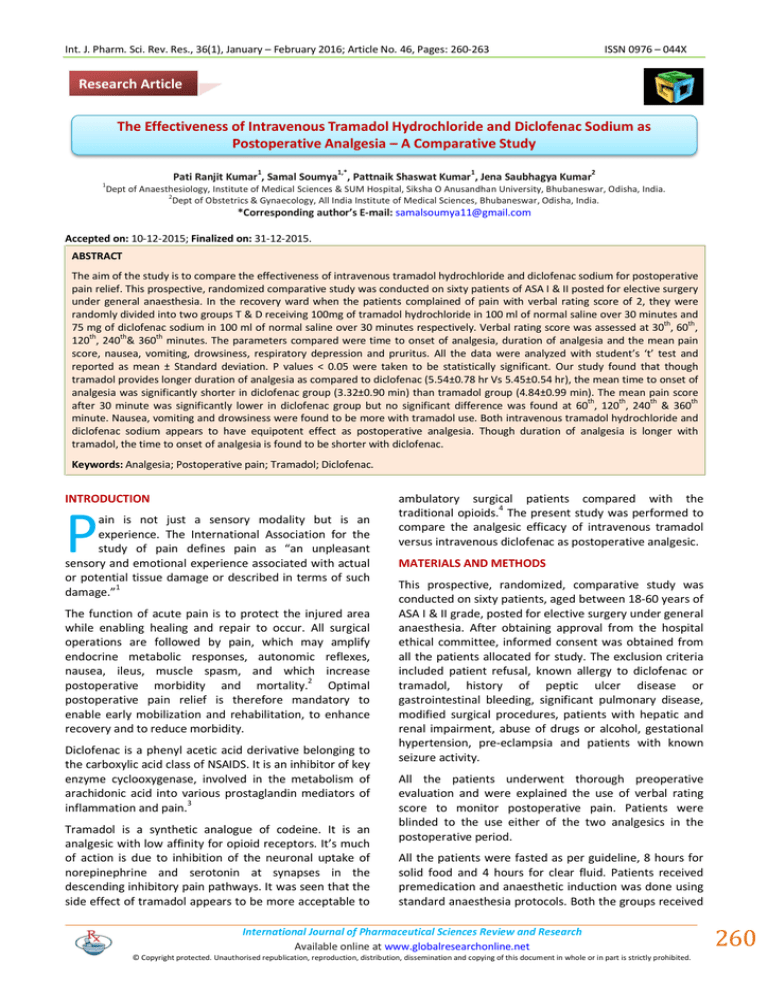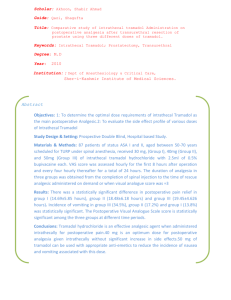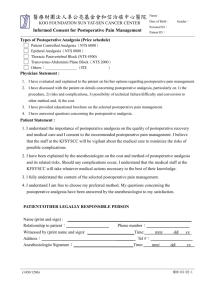Document 13310824
advertisement

Int. J. Pharm. Sci. Rev. Res., 36(1), January – February 2016; Article No. 46, Pages: 260-263 ISSN 0976 – 044X Research Article The Effectiveness of Intravenous Tramadol Hydrochloride and Diclofenac Sodium as Postoperative Analgesia – A Comparative Study 1 1 1,* 1 2 Pati Ranjit Kumar , Samal Soumya , Pattnaik Shaswat Kumar , Jena Saubhagya Kumar Dept of Anaesthesiology, Institute of Medical Sciences & SUM Hospital, Siksha O Anusandhan University, Bhubaneswar, Odisha, India. 2 Dept of Obstetrics & Gynaecology, All India Institute of Medical Sciences, Bhubaneswar, Odisha, India. *Corresponding author’s E-mail: samalsoumya11@gmail.com Accepted on: 10-12-2015; Finalized on: 31-12-2015. ABSTRACT The aim of the study is to compare the effectiveness of intravenous tramadol hydrochloride and diclofenac sodium for postoperative pain relief. This prospective, randomized comparative study was conducted on sixty patients of ASA I & II posted for elective surgery under general anaesthesia. In the recovery ward when the patients complained of pain with verbal rating score of 2, they were randomly divided into two groups T & D receiving 100mg of tramadol hydrochloride in 100 ml of normal saline over 30 minutes and th th 75 mg of diclofenac sodium in 100 ml of normal saline over 30 minutes respectively. Verbal rating score was assessed at 30 , 60 , th th th 120 , 240 & 360 minutes. The parameters compared were time to onset of analgesia, duration of analgesia and the mean pain score, nausea, vomiting, drowsiness, respiratory depression and pruritus. All the data were analyzed with student’s ‘t’ test and reported as mean ± Standard deviation. P values < 0.05 were taken to be statistically significant. Our study found that though tramadol provides longer duration of analgesia as compared to diclofenac (5.54±0.78 hr Vs 5.45±0.54 hr), the mean time to onset of analgesia was significantly shorter in diclofenac group (3.32±0.90 min) than tramadol group (4.84±0.99 min). The mean pain score th th th th after 30 minute was significantly lower in diclofenac group but no significant difference was found at 60 , 120 , 240 & 360 minute. Nausea, vomiting and drowsiness were found to be more with tramadol use. Both intravenous tramadol hydrochloride and diclofenac sodium appears to have equipotent effect as postoperative analgesia. Though duration of analgesia is longer with tramadol, the time to onset of analgesia is found to be shorter with diclofenac. Keywords: Analgesia; Postoperative pain; Tramadol; Diclofenac. INTRODUCTION P ain is not just a sensory modality but is an experience. The International Association for the study of pain defines pain as “an unpleasant sensory and emotional experience associated with actual or potential tissue damage or described in terms of such damage.”1 The function of acute pain is to protect the injured area while enabling healing and repair to occur. All surgical operations are followed by pain, which may amplify endocrine metabolic responses, autonomic reflexes, nausea, ileus, muscle spasm, and which increase postoperative morbidity and mortality.2 Optimal postoperative pain relief is therefore mandatory to enable early mobilization and rehabilitation, to enhance recovery and to reduce morbidity. Diclofenac is a phenyl acetic acid derivative belonging to the carboxylic acid class of NSAIDS. It is an inhibitor of key enzyme cyclooxygenase, involved in the metabolism of arachidonic acid into various prostaglandin mediators of inflammation and pain.3 Tramadol is a synthetic analogue of codeine. It is an analgesic with low affinity for opioid receptors. It’s much of action is due to inhibition of the neuronal uptake of norepinephrine and serotonin at synapses in the descending inhibitory pain pathways. It was seen that the side effect of tramadol appears to be more acceptable to ambulatory surgical patients compared with the traditional opioids.4 The present study was performed to compare the analgesic efficacy of intravenous tramadol versus intravenous diclofenac as postoperative analgesic. MATERIALS AND METHODS This prospective, randomized, comparative study was conducted on sixty patients, aged between 18-60 years of ASA I & II grade, posted for elective surgery under general anaesthesia. After obtaining approval from the hospital ethical committee, informed consent was obtained from all the patients allocated for study. The exclusion criteria included patient refusal, known allergy to diclofenac or tramadol, history of peptic ulcer disease or gastrointestinal bleeding, significant pulmonary disease, modified surgical procedures, patients with hepatic and renal impairment, abuse of drugs or alcohol, gestational hypertension, pre-eclampsia and patients with known seizure activity. All the patients underwent thorough preoperative evaluation and were explained the use of verbal rating score to monitor postoperative pain. Patients were blinded to the use either of the two analgesics in the postoperative period. All the patients were fasted as per guideline, 8 hours for solid food and 4 hours for clear fluid. Patients received premedication and anaesthetic induction was done using standard anaesthesia protocols. Both the groups received International Journal of Pharmaceutical Sciences Review and Research Available online at www.globalresearchonline.net © Copyright protected. Unauthorised republication, reproduction, distribution, dissemination and copying of this document in whole or in part is strictly prohibited. 260 Int. J. Pharm. Sci. Rev. Res., 36(1), January – February 2016; Article No. 46, Pages: 260-263 uniform preoperative and intra-operative medications. After extubation patients were shifted to the recovery room and all the vitals were monitored and recorded. Oxygen through venturi mask was administered to all the patients. When patients started complaining of pain with a verbal rating scale (VRS) of 2, they were allocated randomly into two groups, first group (T) received intravenous Tramadol 100mg in 100ml of normal saline over 30 minutes and the second group (D) received intravenous Diclofenac 75mg in 100ml of normal saline over 30 minutes. Verbal rating score (0-No pain, 1-Mild pain, 2-Moderate pain, 3-Severe pain) was assessed at th th th th th 30 , 60 , 120 , 240 , & 360 minutes of giving postoperative analgesia and vitals recorded simultaneously. Additional doses of analgesia were administered if VRS was more than 2 or on demand. ISSN 0976 – 044X analyzed with student’s‘t’ test and reported as mean ± SD. P values < 0.05 were taken to be statistically significant. RESULTS In this study, a total of 60 patients who were posted for surgery under general anaesthesia were recruited randomly into two groups T and D, each of 30 patients. The two groups were comparable with respect to mean age, sex, weight, physical status and duration of surgery. The demographic data are compared and shown in table 1. There was statistically significant difference in the mean values of the onset of analgesia. Onset of analgesia in group T was 4.84±0.99 minutes and group D was 3.32±0.90 minutes, which shows that group D patients had quicker onset of analgesia (Table 2). All the complications during patients stay in recovery room were recorded and managed accordingly. Duration of analgesia in group T was 5.54± 0.78 hours and group D was 5.45±0.54hours, which showed that group T patients had longer duration analgesia than group D. All the observations were recorded in the patient performa and the relevant details were made into a master chart. Statistical analyses were performed using the statistical package SPSS version 22. All the data were Table 1: Demographic Profile of Patients Variables Group T (n=30) Mean ± SD Group D(n=30) Mean ± SD P-value Age (years) 41.48 ± 15.07 38.68 ± 12.92 0.0729(NS) Male / Female 14 : 16 15 : 15 Weight (Kg) 53.64 ± 8.81 53.62 ± 8.84 ASA I: ASA II 15 : 15 15 : 15 Duration of surgery (minutes) 158.00 ± 45.06 159.00 ± 44.39 0.101 (NS) 0.795 (NS) Table 2: Onset & Duration of Analgesia Variables Group T ( n=30) Mean ± SD Group D( n=30) Mean ± SD P- value Time for onset of analgesia (minutes) 4.84 ± 0.99 3.32 ± 0.90 0.001 (S) Duration of analgesia (hours) 5.54 ± 0.78 5.45 ± 0.54 0.001( S) Table 3: Postoperative Pain Score Time Group T (n=30) Mean ± SD Group D (n=30) Mean ± SD P-value Mean ± SD 0 hr 2.16± 0.37 2.26± 0.41 0.122(NS) 30 min 1.48± 0.89 1.16± 0.75 0.001(S) 60 min 0.62± 0.74 0.74± 0.70 0.327(NS) 120 min 0.40± 0.65 0.56± 0.50 0.103(NS) 240 min 1.32± 0.96 1.52± 0.48 0.118(NS) 360 min 2.18 ±0.35 2.37 ±0.32 0.351(NS) Table 4: Postoperative Complications Adverse Effects Group T n=30 (%) Group D n=30(%) Nausea 7 (23.33%) 5(16.6%) Vomiting 3 (10%) 2 (6.66%) Drowsing 5 (16.6%) - Respiratory depression - - Pruritus - - International Journal of Pharmaceutical Sciences Review and Research Available online at www.globalresearchonline.net © Copyright protected. Unauthorised republication, reproduction, distribution, dissemination and copying of this document in whole or in part is strictly prohibited. 261 Int. J. Pharm. Sci. Rev. Res., 36(1), January – February 2016; Article No. 46, Pages: 260-263 DISCUSSION The real art of anaesthesia lies not only in the anaesthetic management of the surgical patients but also in treating postoperative pain. Failure to treat postoperative pain 5 may lead to high incidence of morbidity and mortality. Morphine is the standard opioid used for post operative pain relief, but due to its side effects like nausea, vomiting and respiratory depression, efforts had been made to search for many newer alternatives. Tramadol hydrochloride is one such drug and is less potent than morphine. It has a lower potential for abuse and psychological dependence. Tramadol has proved to be an effective analgesic that is well tolerated by adult and pediatric patients. Diclofenac is a nonsteroidal anti-inflammatory drug with potent analgesic action, by inhibiting the synthesis of prostaglandins and is known to accumulate in inflamed tissue where its concentrations are maintained much higher than in plasma for many hours. It also has active metabolites that act as analgesics. The clinical benefit of higher doses in postoperative pain would be questionable because of the risk of nephrotoxicity. These NSAIDs can cause impairment of glomerular filtration, acute renal failure. The present study was designed to compare the effects of intravenous tramadol and intravenous diclofenac for postoperative pain relief. There were no differences between the groups in patient’s characteristics (sex, age, and weight), type of surgery and duration of anaesthesia. In our study we found that the onset of analgesia was more rapid with intravenous diclofenac (3.32±0.90min) compared to tramadol (4.48±0.99min), the difference being highly significant (P<0.01). The duration of analgesia effect was 5.45±0.54 hrs with diclofenac and 5.54±0.78 hrs with tramadol, the difference being highly significant(P<0.001). Zahid Ahmed did a clinical comparison on postoperative analgesia of intramuscular diclofenac sodium with tramadol hydrochloride and concluded that analgesic effect of 100mg tramadol hydrochloride lasted up to 24 hours 6 while that of diclofenac sodium lasted 6 to 8 hours. The long term effects of tramadol may be explained on the view that by-product metabolites of tramadol produce an active metabolite (o-demethyl Tramadol) which is an active analgesic while the by-product of diclofenac sodium is pharmacologically inactive.7 In a study comparing tramadol with diclofenac in post cesarean patients it was found that the mean time to rescue dose of diclofenac was much shorter as compared 8 to tramadol. Significant postoperative analgesia was experienced from th th the 30 minute to 300 minute in both the groups though tramadol group showed slightly better pain relief compared to diclofenac group. ISSN 0976 – 044X In the present study, 7 patients had nausea and 3 developed vomiting in the tramadol group, where as 5 patients had nausea and 2 developed vomiting in the diclofenac group. Incidence of drowsiness was high in tramadol group. None of the patients showed signs of respiratory depression. Vickers concluded that tramadol transiently depressed the rate of respiration but had no effect on end tidal 9 carbon dioxide tension. Irfan Shah compared the efficacy of tramadol hydrochloride with diclofenac sodium and concluded that 10 tramadol can be safely used for postoperative analgesia. Sinha found that intravenous tramadol (50mg diluted with 2 ml normal saline) is better in relieving pain than intravenous diclofenac (75mg diluted with 2ml normal saline) in laparoscopic cholecystectomy administered at 0, 8, 16 & 24 hours postoperatively, though it is associated with higher incidence of nausea and vomiting.11 Our patients can be considered low-risk patients for renal complications as they were free from preoperative renal problems. There were no clinical signs of hemostatic disturbances such as increased postoperative bleeding or development of hemotomas. In both the groups, there was adequate pain relief with reference to onset and duration of analgesia. All patients in both groups of our study required additional doses of analgesics after 360th minute postoperatively. WilderSmith showed that, the combination of intramuscular tramadol and intramuscular diclofenac is more effective for postoperative analgesia and prevention of sensitization than the two drugs given individually.8 Laitinen J concluded that the addition of diclofenac led to reduction in fentanyl requirement after total hip replacement.12 Soumya Samal and her colleagues concluded that, a combination of Diclofenac 75mg along with 1gm of Paracetamol given as a slow intravenous infusion, for post operative pain relief, gives a better quality, longer duration of analgesia, with lesser number of rescue analgesia, compared to infusion of 75mg of 13 Diclofenac alone. Other studies have shown that combination of narcotics and non-narcotic analgesics may give better results than tramadol alone.14,15 CONCLUSION Both intravenous tramadol hydrochloride and diclofenac sodium after single dose infusion appears to have equipotent effect as far as postoperative analgesia is concerned. Postoperative nausea and vomiting may be a problem with tramadol, but duration of postoperative analgesia is a little better as compared to diclofenac. In terms of quicker onset in postoperative analgesia diclofenac appears to be a better choice. International Journal of Pharmaceutical Sciences Review and Research Available online at www.globalresearchonline.net © Copyright protected. Unauthorised republication, reproduction, distribution, dissemination and copying of this document in whole or in part is strictly prohibited. 262 Int. J. Pharm. Sci. Rev. Res., 36(1), January – February 2016; Article No. 46, Pages: 260-263 and the effects of single im doses of tramadol and diclofenac alone and in combination. Anesth Analg. 97(2), 2003, 526-33. REFERENCES 1. 2. 3. 4. 5. 6. 7. 8. Merskey H, Albe-Fessard DG, Bonica JJ, et al. Pain terms: a list with definitions and notes on usage: recommended by the IASP Subcommittee on Taxonomy. Pain. 6(3), 1979, 249–52. Kehlet H. Multimodal approach to control postoperative pathophysiology and rehabilitation. Br J Anaesth. 78(5), 1997, 606–617. Hyrkas T, Ylipaavalnicmi P, Oikarinen VJ, Paakkari I. Preoperative intravenous diclofenac for postoperative pain prevention in outpatients. Br J Oral Maxillofac Surg. 319(6), 1993, 351–354. doi: 10.1016/0266-4356(93)90189-4. Olmedo MV, Galvez R, Vallecillo M. Double- blind parallel comparison of multiple doses of ketorolac, ketoprofen and placebo administered orally to patients with postoperative dental pain. Pain. 90(1-2), 2001, 135-141. Christopher LV. Acute postoperative pain in Roland D. th Miller Anaesthesia:6 Edition; New York Churchill living stone, 2005, 2729-2962. Hasmi ZA, Bashir G, Shah SA. Tramadol hydrochloride in postoperative analgesia: clinical comparision with Diclofenac sodium. Gomal Journal of Medical Sciences. 2(2), 2004, 47-49. Raffa RB, Friedrichs E, Reimann W, Shank RP. Opioid and non-opioid components independently contribute to the mechanism of action of Tramadol, a typical opioid analgesic. J Pharmacology Exp Ther, 260(1), 1992, 275-285. ISSN 0976 – 044X 9. Vickers MD, O’Flaherty D, Szekely SM, Read M, Yoshizumi J. Tramadol-pain relief by an opioid without depression of respiration. Anaesthesia. 47(4), 1992, 291-292. 10. Shah I, Zaeem K, Ibrahim MW, Hussain I, Hassan A. Comparison of analgesic efficacy of tramadol hydrochloride with Diclofenac sodium in dento-alveolar surgery. Pakistan Oral & Dental Journal. 28(2), 2008, 241-244. 11. Sinha SP, Sinha S, Sharma SC, Jain S, Hai A. Efficacy of tramadol V/s diclofenac in management of post laparoscopic cholecystectomy pain. International journal of scientific study. 01(3), 2013, 89-94. 12. Laitinen J, Nuutinen L. Intravenous diclofenac coupled with PCA fentanyl for pain relief after total hip replacement. Anaesthesiology, 76(2), 1992, 194-198. 13. S Samal, E John, L Chandrasekar, S Nithianandam, Jena S K. A Comparative Study of Intravenous Diclofenac and Combination of Intravenous Paracetamol with Intravenous Diclofenac for the Postoperative Pain Management. The Internet Journal of Anesthesiology. 32(2), 2013, 1-5. 14. Medve RA, Wang J, Karim R. Tramadol and acetaminophen tablets for dental pain. Anaesthesia Progress. 48(3), 2001, 79-81. 15. Mehlisch DR. The efficacy of combination analgesic therapy in relieving dental pain. JADA. 133(7), 2002, 861-871. Wilder-Smith CH, Hill L, Dyer RA, Torr G, Coetzee E. Postoperative sensitization and pain after cesarean delivery Source of Support: Nil, Conflict of Interest: None. International Journal of Pharmaceutical Sciences Review and Research Available online at www.globalresearchonline.net © Copyright protected. Unauthorised republication, reproduction, distribution, dissemination and copying of this document in whole or in part is strictly prohibited. 263


